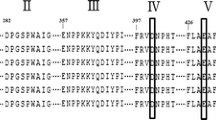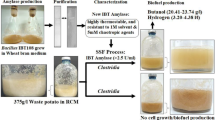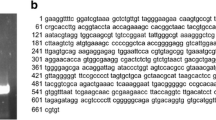Abstract
Raw starch is the most abundant source of glucose in the world. Therefore, finding enzymes capable of digesting raw starch would find high industrial demand. The α-amylase gene of Bacillus amyloliquefaciens ATCC 23842 was amplified, cloned and overexpressed in Escherichia coli BL21 (DE3) cells. The recombinant enzyme was purified to apparent homogeneity using ion exchange and gel filtration chromatography. The raw-starch digestibility of the purified enzyme was characterized by studying the hydrolysis and adsorption rate on a variety of raw starches (potato, cassava, corn, wheat and rice). The raw-starch digestion was further confirmed by scanning electron microscopy studies, which revealed an effective rate of hydrolysis. The kinetic studies revealed a relatively low K m of 2.76 mg/mL, exhibiting high affinity towards the soluble starch as the most preferred substrate and the inhibition kinetic studies revealed a high K i value (350 mM).
Similar content being viewed by others
Abbreviations
- CBM:
-
carbohydrate-binding module
- IPTG:
-
isopropyl β-D-thiogalactopyranoside
- LB:
-
Luria Bertani
- SBD:
-
starch-binding module
- SEM:
-
scanning electron microscopy
References
Abe A., Tonozuka T., Sakano Y. & Kamitori S. 2004. Complex structures of Thermoactinomyces vulgaris R-47 α-amylase 1 with maltooligosaccharides demonstrate the role of domain N acting as a starch-binding domain. J Mol Biol. 335: 811–822.
Ashikari T., Nakamura N., Tanaka Y., Kiuchi N., ShiBano Y., Tanaka T., Amachi T. & Yoshizumi H. 1986. Rhizopus rawstarch-degrading glucoamylase: its cloning and expression in yeast. Agric. Biol. Chem. 50: 957–964.
Benson D.A., Karsch-Mizrachi I., Lipman D.J., Ostell J. & Sayers E.W. 2010. GenBank. Nucleic Acids Res. 38 (Database Issue): D46–D51.
Bibel M., Brettl C., Gosslar U., Kriegshaeuser G. & Liebl W. 1998. Isolation and analysis of genes for amylolytic enzymes of the hyperthermophilic bacterium Thermotoga maritima. FEMS Microbiol Lett. 158: 9–15.
Borgia P.T. & Campbell L.L. 1978. α-Amylase from five strains of Bacillus amyloliquefaciens: evidence for identical primary structures. J. Bacteriol. 134: 389–393.
Champreda V., Kanokratana P., Sriprang R., Tanapongpipat S. & Eurwilaichitr L. 2007. Purification, biochemical characterization and gene cloning of a new extracellular thermotolerant and glucose tolerant maltooligosaccharide forming α-amylase from an endophytic Fusicoccum sp. BCC 4124. Biosci. Biotechnol. Biochem. 71: 2010–2020.
Christiansen C., Hachem M.A., Janecek S., Vikso-Nielsen A., Blennow A. & Svensson B. 2009. The carbohydrate-binding module family 20 — diversity, structure, and function. FEBS J. 276: 5006–5029.
Chung H. & Friedberg F. 1980. Sequence of the N-terminal half of Bacillus amyloliquefaciens α-amylase. Biochem. J. 185: 387–395.
Dauter Z., Dauter M., Brzozowski A.M., Christensen S., Borchert T.V., Beier L., Wilson K.S. & Davies G.J. 1999. X-ray structure of Novamyl, the five-domain ‘maltogenic’ α-amylase from Bacillus stearothermophilus: maltose and acarbose complexes at 1.7 Å resolution. Biochemistry 38: 8385–8392.
Demirkan E.S., Mikami B., Adachi M., Higasa T. & Utsumi. 2005 α-Amylase from B. amyloliquefaciens: purification, characterization, raw starch degradation and expression in E. coli. Process Biochem. 40: 2629–2636.
Detera S.D. & Friedberg F. 1979. Molecular weight of B. subtilis α-amylase derived from chemical studies. Int. J. Pept. Protein Res. 14: 364–372.
Gangadharan D., Nampoothiri K.M., Sivaramakrishnan S. & Pandey A. 2009. Biochemical characterization of raw-starchdigesting α-amylase purified from Bacillus amyloliquefaciens. Appl. Biochem. Biotechnol. 158: 653–662.
Gangadharan D., Sivaramakrishnan S., Nampoothiri K.M. & Pandey A. 2006. Solid culturing of Bacillus amyloliquefaciens for α-amylase production. Food Technol. Biotechnol. 44: 269–274.
Gangadharan D., Sivaramakrishnan S., Nampoothiri K.M., Sukumaram R.K. & Pandey A. 2008. Response surface methodology for the optimization of α-amylase production by Bacillus amyloliquefaciens. Bioresource Technol. 99: 4597–4602.
Gobius K.S. & Pemberton J.M. 1988. Molecular cloning, characterization, and nucleotide sequence of an extracellular amylase gene from Aeromonas hydrophila. J. Bacteriol. 170: 1325–1332.
Hamilton L.M., Kelly C.T. & Fogarty W.M. 1998. Raw starch degradation by the non-raw starch-adsorbing bacterial α- amylase of Bacillus sp. IMD 434. Carbohyd Res. 314: 251–257.
Hayashida S., Teramoto Y., Inoue T. & Mitsuiki S. 1990. Occurrence of an affinity site apart from the active site on the raw-starch-digesting but non-raw-starch-adsorbable Bacillus subtilis 65 α-amylase. Appl. Environ. Microbiol. 56: 2584–2586.
Hyun H.H. & Zekius J.G. 1985. Biochemical characterization of thermostable extracellular β-amylase from Clostridium thermosulfurogenes. Appl. Environ. Microbiol. 49: 1162–1167.
Iefuji H., Chino M., Kato M. & Iimura Y. 1996. Raw-starchdigesting and thermostable α-amylase from yeast Cryptococcus sp. S-2: purification, characterization, cloning and sequencing. Biochem. J. 318: 989–996.
Itkor P., Tsukagoshi N. & Udaka S. 1989. Purification and properties of divalent cation-dependent raw-starch-digesting α-amylase from Bacillus sp. B1018. J. Ferment. Bioeng. 68: 247–251.
Janecek S. 1997. α-Amylase family: molecular biology and evolution. Prog. Biophys. Mol. Biol. 67: 67–97.
Jeang C.L., Chen L.S., Chen M.Y. & Shiau R.J. 2002. Cloning of a gene encoding raw-starch-digesting amylase from a Cytophaga sp. and its expression in Escherichia coli. Appl. Environ. Microbiol. 68: 3651–3654.
Kelly C.T., McTigue M.A., Doyle E.M. & Fogarty W.M. 1995. The raw starch degrading amylase of Bacillus sp. IMD 370. J. Ind. Microbiol. Biotechnol. 15: 446–448.
Lineweaver H. & Burk D. 1934. The determination of enzyme dissociation constants. J. Am. Chem. Soc. 56: 658–666.
Liu Y., Shen W., Shi G. & Wang Z. 2010. Role of the calciumbinding residues Asp231, Asp233, and Asp438 in α-amylase of Bacillus amyloliquefaciens as revealed by mutational analysis. Curr. Microbiol. 60: 162–166.
Lo H.F., Lin L.L., Chiang W.Y., Chie M.C., Hsei W.H. & Chang C.T. 2002. Deletion analysis of the C-terminal region of the α-amylase of Bacillus sp. strain TS-23. Arch. Microbiol. 178: 115–123.
Lowry O.H., Rosebrough N.J., Farr A.L. & Randall R.J. 1951. Protein measurement with the Folin phenol reagent. J. Biol. Chem. 193: 263–275.
MacGregor A.W., Bazin S.L. & Izydorczyk M.S. 2002. Gelatinisation characteristics and enzyme susceptibility of different types of barley starch in the temperature range 48–72°C. J. Inst. Brew. 108: 43–47.
Mikami B., Adachi M., Kage T., Sarikaya E., Nanmori T., Shinke R. & Utsumi S. 1999. Structure of raw starch-digesting Bacillus cereus β-amylase complexed with maltose. Biochemistry 38: 7050–7061.
Miller G.L. 1959. Use of dinitrosalicylic acid reagent for determination of reducing sugar. Anal. Chem. 31: 426–429.
Mitsuiki S., Mukaea K., Sakai M., Goto M., Hayashida S. & Furukawa K. 2005. Comparative characterization of raw starch hydrolyzing α-amylases from various Bacillus strains. Enzyme Microb. Technol. 37: 410–416.
Okolo B.N., Ezeogu L.I. & Mba C.N. 1995. Production of raw starch digestive amylase by Aspergillus niger grown on native starch sources. J. Sci. Food Agric. 69: 109–115.
Palva I., Pettersson R.F., Kalkkinen N., Lehtovaara P., Sarvas M., Soderlund H., Takkinen K., & Kaariainen L. 1981. Nucleotide sequence of the promoter and NH2-terminal signal peptide region of the α-amylase gene from Bacillus amyloliquefaciens. Gene 15: 43–51.
Penninga D., van der Veen B.A., Knegtel R.M.A., van Hijum S.A.F.T., Rozeboom H.J., Kalk, K.H., Dijstra B.W. & Dijkhuizen L. 1996. The raw starch binding domain of cyclodextrin glycosyltransferase from Bacillus circulans strain 251. J. Biol. Chem. 271: 32777–32784.
Quigley T.A., Kelly C.T., Doyle E.M. & Fogarty W.M. 1998. Patterns of raw starch digestion by the glucoamylase of Cladosporium gossypiicola ATCC 38026. Enzyme Microb. Technol. 33: 677–681.
Sambrook J., Fritsch F.E. & Maniatis T. 1989. Molecular Cloning: A Laboratory Manual, 2nd Edn. Cold Spring Harbor, Cold Spring Harbor Laboratory Press.
Sivaramakrishnan S., Gangadharan D., Nampoothiri K.M. & Pandey A. 2006. α-Amylases from microbial sources — an overview on recent developments. Food Technol. Biotechnol. 44: 173–184.
Sorimachi K., Le Gal Coeffet M.F., Williamson G., Archer D.B. & Williamson M.P. 1997 Solution structure of the granular starch binding domain of Aspergillus niger glucoamylase bound to β-cyclodextrin. Structure 5: 647–661.
Southall S.M., Simpson P.J., Gilbert H.J., Williamson G. & Williamson M.P. 1999. The starch-binding domain from glucoamylase disrupts the structure of starch. FEBS Lett. 447: 58–60.
Southgate V.J., Steyn R.J.C., Pretorius I.S. & Vuuren H.J.J.V. 1993. Expression and secretion of Bacillus amyloliquefaciens α-amylase by using the yeast pheromone CL-factor promoter and leader sequence in Saccharomyces cerevisiae. Appl. Environ. Microbiol. 59: 1253–1258.
Svensson B., Jespersen H., Sierks M.R. & MacGregor E.A. 1989. Sequence homology between putative raw-starch binding domains from different starch-degrading enzymes. Biochem. J. 264: 309–311.
Takahashi T., Kato K., Ikegami Y. & Irie M. 1985. Different behavior toward raw starch of three forms of glucoamylase from a Rhizopus sp. J. Biochem. 98: 663–671.
Takkinen K., Pettersson R.F., Kalkkinen N., Palva I., Soderlund H. & Kaariainen L. 1983. Amino acid sequence of α-amylase from Bacillus amyloliquefaciens deduced from the nucleotide sequence of the cloned gene. J. Biol. Chem. 258: 1007-1013.
van der Maarel M.J.E.C., van der Veen B., Uitdehaag J.C.M., Leemhuis H. & Dijkhuizen L. 2002. Properties and applications of starch-converting enzymes of the α-amylase family. J. Biotechnol. 94: 137–155.
Vidilaseris K., Hidayat K., Retnoningrum D.S., Nurachman Z., Noer A.S. & Natalia D. 2009. Biochemical characterization of a raw starch degrading α-amylase from the Indonesian marine bacterium Bacillus sp. ALSHL3. Biologia 64: 1047–1052.
Yetti M., Nazamid B.S., Roselina K. & Abdulkarim S.M. 2007. Improvement of glucose production by raw starch degrading enzyme utilizing acid-treated sago starch as substrate. ASEAN Food J. 14: 83–90.
Yuuki T., Nomura T., Tezuka H., Tsuboi A., Yamagata H., Tsukagoshi N. & Udaka S. 1985. Complete nucleotide sequence of a gene coding for heat- and pH-stable α-amylase of Bacillus licheniformis: comparison of the amino acid sequences of three bacterial liquefying α-amylases deduced from the DNA sequences. J. Biochem. 98: 1147–1156.
Author information
Authors and Affiliations
Corresponding author
Rights and permissions
About this article
Cite this article
Gangadharan, D., Ramachandran, P., Paramasamy, G. et al. Molecular cloning, overexpression and characterization of the raw-starch-digesting α-amylase of Bacillus amyloliquefaciens . Biologia 65, 392–398 (2010). https://doi.org/10.2478/s11756-010-0042-6
Received:
Accepted:
Published:
Issue Date:
DOI: https://doi.org/10.2478/s11756-010-0042-6




